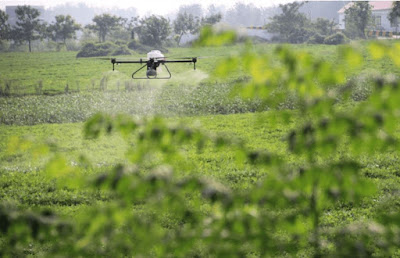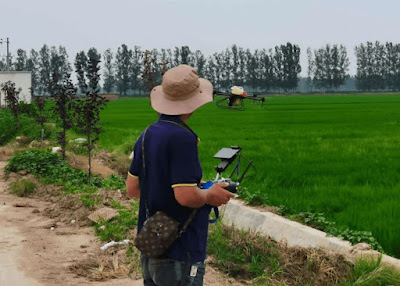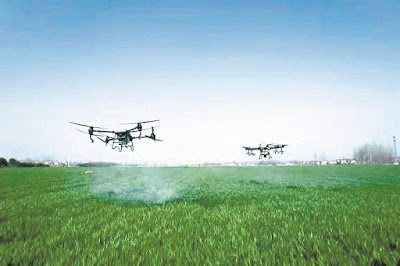With the advancement of the times and technology, the use of drones in agriculture and forestry to replace manual pesticide application has gradually been recognized by the market. However, drones also have their advantages as well as disadvantages, only by well understanding which, can they serve us better.
Merits of Drone Spraying
Drones spraying saves time and labor
The speed of the drone application operation is quite fast. It takes dozens of minutes to do the work, which is equivalent to the workload of one day or even two days of manual work, and the efficiency is quite high. For example, when working on ten acres of land, it takes about 2 days for a single person to spray pesticides manually, and it can be easily completed in about 20 minutes using a plant protection drone. Therefore, the efficiency of drones is dozens of times higher than that of humans. In addition, most of the diseases and insect pests caused by crops will break out in a short period of time. The sooner the prevention and control is done, the damage to crops can be minimized and yield reduction can be avoided. Therefore, UAV operations are time-saving, labor-saving, fast and efficient.
Drones spraying has higher degree of atomization and is more uniform
Drones spraying is less restricted by terrains
Save water and pesticides
An electric sprayer, we count it as 30 liters of water. According to the habits of our farmers and friends, it can generally hit seven or eight points of land, and some of them can go fast and can hit an acre of land. The water consumption of drones to hit one mu of land is about 1 kg, which is 2 catties of water. In terms of the dosage, it is also a acre of land. In sunny and windless weather, the dosage of the drone is 1/2 or 2/3 of the sprayer, and the dosage is reduced by at least 1/3. Of course, if the weather is windy, there will be drift and some waste. At the same time, if some pests and diseases with relatively high resistance are encountered, the amount of drone spraying should also be increased.
In the pesticide spraying process, due to the low-volume spraying technology, agricultural drones can save 29 liters of agricultural water per mu compared to manual operations. One billion mu of operation is equivalent to reducing agricultural water consumption by 29 million tons. This is equivalent to the annual drinking water of 52.72 million residents. While achieving the control effect, it also saves a lot of valuable water resources.
Disadvantages of Agricultural Drones
On the contrary, drone spraying also has shortcomings, and it is not suitable for any situation. We still need to look at drones objectively.
Hard to penetrate high-stem crops
This may be also the biggest disadvantage of drone spraying. When the wheat is in the middle and late stages of maturity, many diseases and insect pests on wheat, such as aphids and rust, are not only on the upper part, but also in the middle and lower parts. Although the drones are evenly sprayed, the drones of some manufacturers lack market experience in design and have insufficient optimization. In actual use, it is easy to be unable to penetrate, that is to say, the lower part cannot be hit, let alone the rhizome. prevention. If the concentration is arbitrarily increased, it is very likely to cause phytotoxicity, and reducing the flying height may cause crop lodging.
Drones are easy to drift when spraying pesticide
Because the drone is a flying operation, if the weather is sunny and windless, it is fine. If the wind exceeds level 3, there may be drug drift, causing phytotoxicity to other crops around, especially when the herbicide is used. Additional attention needs to be paid to changes in the environment.
High overall cost of agricultural drones
For example, some farms or large land owners have their own agricultural drones, and the cost of purchase and maintenance is not low. There are 40,000 drones, 50,000 drones, and 80,000 drones in the first two years. The overall supporting facilities need to be at least 60,000. As a daily use machine, the plant protection drone is inevitably used for a long time to be repaired or maintained. In the process of use, there is a failure or collision, and professional maintenance is required. This cost is not low whether it is repaired locally or returned to the factory.
In addition, the battery, the battery of the drone is also very expensive, and a set of batteries is basically thousands of yuan. At the same time, if the operating area is large, the battery life of a single battery is limited, so several sets of batteries or even generators are usually prepared, and the input cost is higher. In the face of these situations, the shortcomings of drones are exposed, that is, "expensive to buy, expensive to maintain, and unaffordable".
Operation of agricultural drones is more complicated
The operation of agricultural drones requires special learning and skilled operation. This process does not require a few weeks or even a month of training and exploration, and it is difficult to achieve timely and efficient operations when pests and diseases occur. Even if you are very proficient, there will still be various unexpected problems when you are actually working in the field.
Therefore, the use of traditional plant protection drones not only has many advantages, but also has some shortcomings and shortcomings.
In order to minimize the troubles of farmers and friends in the process of use, Shensu Agriculture has been involved in agricultural planting for many years, and has developed products suitable for market use in view of the shortcomings in use. TH series drones not only have 10 liters of small Models, family cars and small tricycles can be easily loaded, which is convenient for transition use, taking into account the intelligence and compactness, and shortening unnecessary waste as much as possible in time; at the same time, it also has a 26-liter large aircraft, which is more efficient for large plots. Work efficiency, more function options.
At the same time, according to the characteristics of agricultural market personnel with different levels of operation and a wide range of age levels, a targeted development of the Shensu Agricultural APP based on Android mobile phones is carried out. Operate the remote control and cooperate with RTK high-precision positioning to take off and land with one key.
According to market feedback, there are two spraying methods, pressure sprinkler and centrifugal atomization sprinkler, to solve the problem of high and low crop penetration from the root.
In order to truly serve the farmers, and in line with the national "Twelfth Five-Year Plan" of "prospering agriculture through science and technology, and policies to benefit agriculture", Shensu Agricultural Innovation has proposed the model of "leasing after leaving the factory, returning the machine and returning the deposit". In the urban area, "Shensu Schindler Service Station" is set up to solve the worries of customers and truly minimize the cost of use. The "Four Exemptions Model" that was first formulated and proposed really makes the common people willing to use it, can afford it, can play it, and can afford it, and it has become a real weapon in agricultural production.






No comments:
Post a Comment